- Army
- Conflicts in the world
- Israel - Iran conflict 2025
- Pakistan - India Conflict 2025
- Russia Ukraine War 2022
- Libya conflict day by day
- HAMAS - Israel War 2023
- Operation Serval in Mali French Army
- Sangaris operation Central African Republic
- Sangaris opération militaire République Centreafrique
- Ukraine - Russia conflict
- Syria conflict news
- Defence & Security Industry Technology
- Armies in the world
- Analysis Defense and Security Industry
- Conflicts in the world
- Navy
- Air
Analysis: New Russian army combat engineer vehicles deployed in Ukraine
According to information published by the Russian Ministry of Defense, a full range of new generations of engineer combat vehicles are now deployed in Ukraine to conduct combat operations including the B12M2 armored bulldozer, KVD Multi-purpose Motorized Rapid Service Roadway Deployment System, Reconnaissance amphibious cushion craft, TMM-7 bridge laying system, BMR-3MA mine clearing tank, UMZ-K multipurpose mine-laying vehicle, UBIM tracked armored engineer vehicle, IMR-3M tracked Armored Obstacle Clearing Vehicle, MTU-2020 tracked bridge laying tank, and Uran-6 unmanned multifunctional demining system.
Follow Army Recognition on Google News at this link
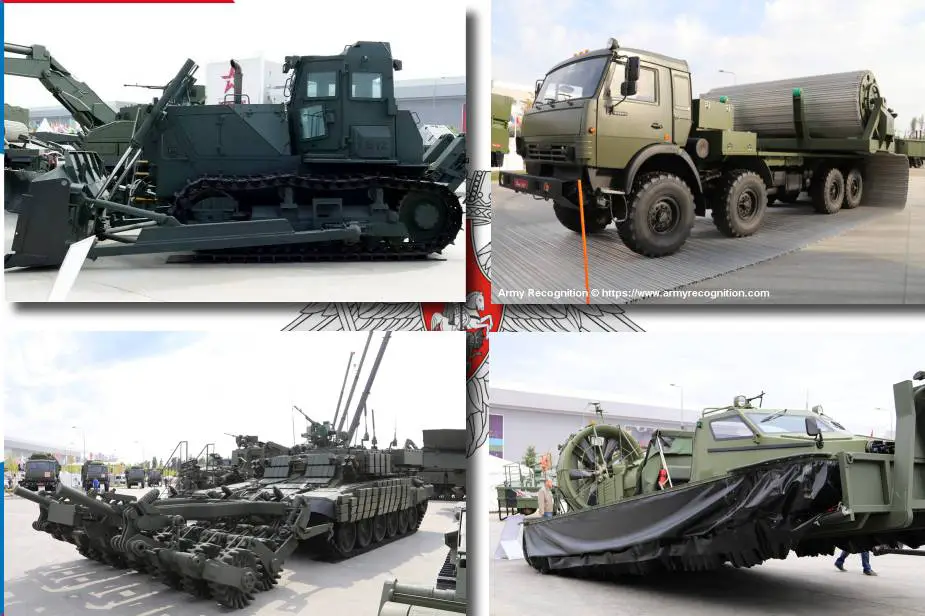
Russian army deploys a full range of new engineer combat vehicles in Ukraine. (Picture source Army Recognition)
In this article, the Army Recognition editorial team presents all these Russian military engineer vehicles with a short technical review for each. The Engineer Troops is a Specialty Branch in the Ground Forces formed to accomplish complex engineering missions in support of combined-arms operations and combat that requires specialized training of personnel and the use of engineer equipment, as well as inflicting casualties on the enemy through the use of engineer charges and explosives.
The Russian engineer troops are organized into formations, units and sub-units for various purposes: engineer reconnaissance, combat engineering, obstacle construction and clearing, engineer assault, road construction, pontoon bridge construction, river assault-crossing, camouflage, engineering technology, field water supply, etc.
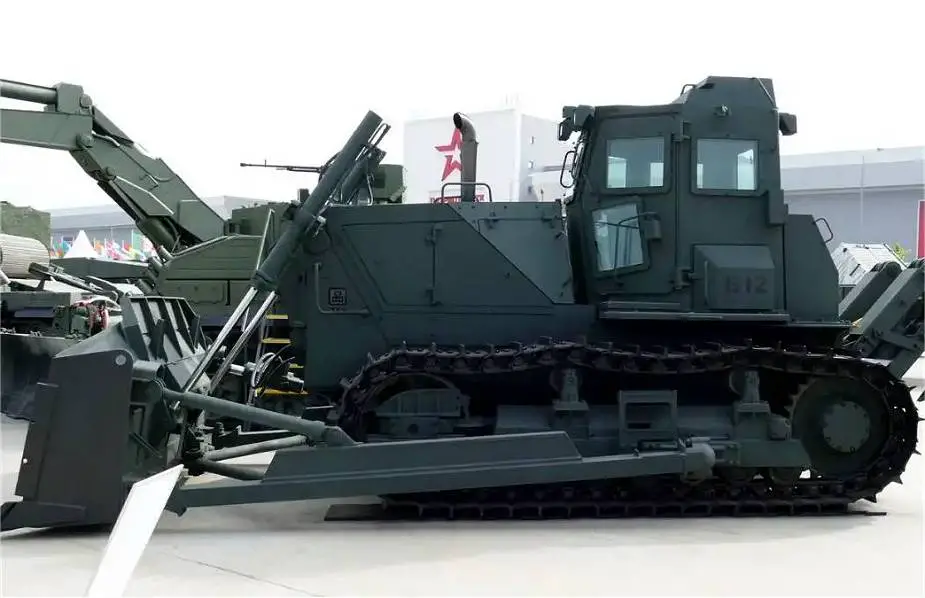
B12M2 engineer combat armored bulldozer vehicle.
B12M2 armored bulldozer vehicle:
The B12M2 is a tracked armored bulldozer that is designed to perform road and excavation works. It has a crew of one soldier and the cabin provides protection against the firing of small arms and artillery shell splinters.
The B12M2 is based on the T-10M2 tractor chassis powered by a Diesel engine developing 140 hp. The vehicle has a weight of 18.8 tons. The front of the vehicle is fitted with a large dozer blade.
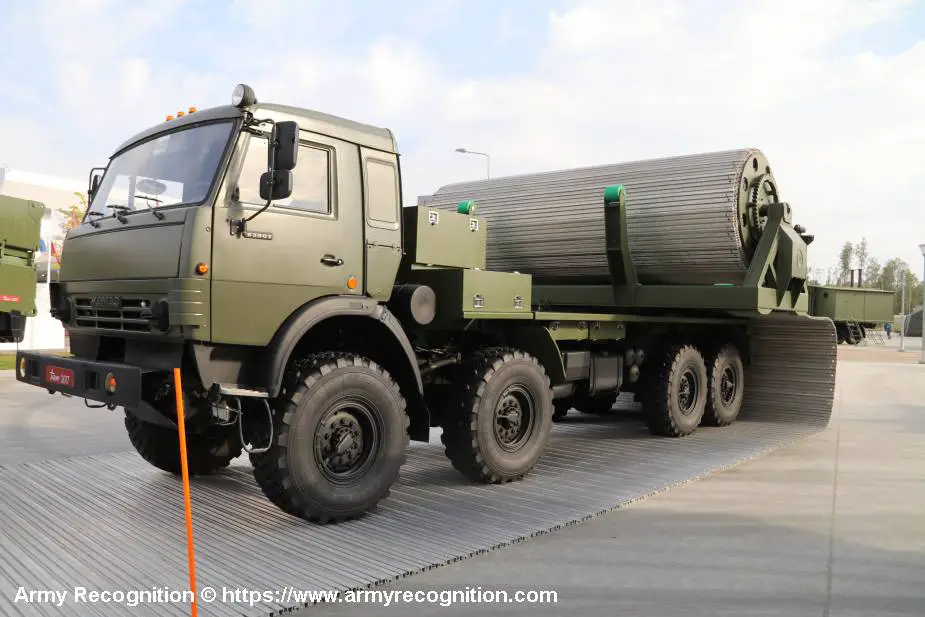
KVD Multi-Purpose Motorized Rapid Service Roadway Deployment System. (Picture source Army Recognition)
KVD Multi-Purpose Motorized Rapid Service Roadway Deployment System
The KVD is based on a KAMAZ63501 8x8 military truck chassis with a two doors crew cab located at the front and a fast deployment system used to deploy a trackway of 50 m in less than 5 minutes.
The multi-purpose motorized rapid service roadway deployment system is designed to ensure the passage of wheeled or tracked combat vehicles over challenging terrain and swampy areas and also to provide approaches to bridges and water-crossing points.
The kit ensures passage of wheeled vehicles of up to 12 tons and tracked combat vehicles weighing up to 60 tons.

TMM-7 truck-mounted bridge laying system. (Picture Army Recognition)
TMM-7
The TMM-7 is a bridge laying system based on a KAMAZ 6350 8x8 military truck chassis with a two doors crew cab at the front and a bridge launcher system at the rear. The vehicle is designed to provide a bridge crossing over narrow obstacles blocking the progress of troops' movements.
A 16 m folded scissor bridge is carried at the rear of the truck. The bridge is launched rearwards using a hydraulic arm and rests on the river floor by means of two variable-length struts. The length of the full-set bridge (4 trucks) is 64 meters. The design weight of the span with support is not heavier than 6 tons, while the TMM-7 load capacity is 60 tons. The maximum traffic capacity is 300 vehicles per hour.

BMR-3MA Unmanned mine-clearing tank for engineer troops. (Picture source Army Recognition)
BMR-3MA Unmanned Mine clearing tank
The BMR-3M is a 50-ton class armored mine clearance combat vehicle intended to clear minefields in support of heavily armored units. BMR-3MA is a remotely operated version of the BMR-3M heavy armored mine clearance vehicle.
The BMR-3M is a tracked mine-clearing vehicle that is based on the tracked chassis of the T-90 tank. The original turret has been removed and replaced by an all-welded superstructure providing protection against the firing of small arms, artillery shell splinters, and mine explosions.
The BMR-3MA is fitted with the KMT-7 tank-mounted mechanical mine-clearing device mounted at the front of the hull. The vehicle is operated by a crew of two-man having the capacity for three engineers and a 5-ton payload in the cargo compartment.
The tread mine clearer KMT-7 with electromagnetic attachment allows clearing paths and lanes at speeds of 5 to 12 kilometers per hour. Additional equipment includes a Radiofrequency Interferometer (RFI) to disable mines with radio proximity fuses, a crane boom with a ratchet winch, night vision devices, and entrenching facilities.

UMZ-K robotized mine laying based on 6x6 truck chassis. (Picture source Army Recognition)
UMZ-K
The UMZ-K is is a robotized mine laying system based on a 6x6 Asteys 7022-3333310 light truck. The mine laying system itself has been produced since the early last decade. The UMZ-K minelayer vehicle is armored to provide protection against the firing of small arms and artillery shell splinters.
The crew of either of both vehicles comprises two men. The vehicles can drive at 40 km/h during mine-laying. The minefields can be eliminated automatically, if necessary. The self-destruction time ranges from 12 hours to 16 days.
The ammunition is carried on a semi-closed vehicle body separated by an armored plate from the driver’s cabin. The design increases crew survivability. The containers with mines are protected by an armored board. The mines are kept in six containers of 30 clusters. The vehicle can carry 180 clusters with munitions. Six units are carried on rotating support with vertical aiming. On the move, they are kept barrel up. They are deployed in the necessary direction and mines are laid. The whole round of munitions is engaged in 15 minutes.

Reconnaissance amphibious cushion craft for engineer troops. (Picture source army Recognition)
Reconnaissance amphibious cushion craft
The reconnaissance amphibious cushion craft is designed to conduct reconnaissance of the battlefield and water barriers during day and night. It is a class of air-cushioned landing craft also called hovercraft which can run on road and water at a maximum speed of 60 km/h with a maximum cruising range of 250 km.
The amphibious cushion craft can move both in water and on land to conduct reconnaissance missions using modern sonar systems. It is also equipped with a wide range of engineering equipment. A crew cabin is located at the front of the boat while the propulsion engine is at the rear. The roof of the crew cabin is equipped with one 7.62mm machine gun.
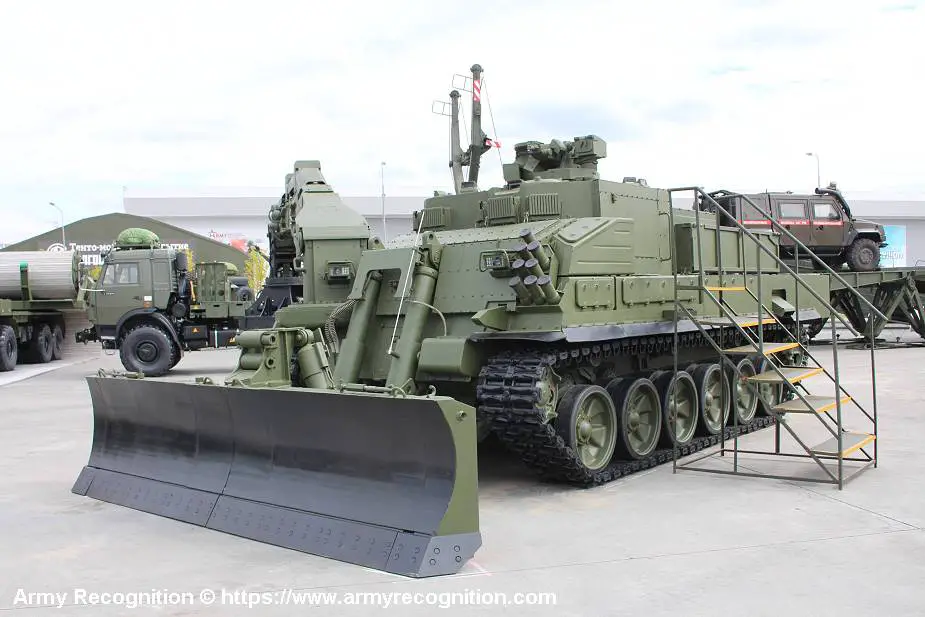
UBIM tank engineer armored vehicle base on T-90 tank chassis. (Picture source Army Recognition)
UBIM
The UBIM is a new Russian armored engineer vehicle based on the tracked chassis of the T-90 tank. The turret has been removed and replaced by an armored cabin. The vehicle is designed to perform mine-clearing operations or removed obstacles.
The UBIM is fitted with a large dozer blade mounted at the front of the hull and a powerful hydraulic jackhammer located at the rear of the chassis. The dozer blade can be used for earthmoving operations, grading, road clearing, filling ditches, and obstacle removal.
The UBIM is operated by a crew of 2, including the driver and vehicle commander/operator. It can carry 3 additional engineers, sappers or infantrymen. The roof of the armored cabin is fitted with a remotely-controlled weapon station armed with one 12.7 mm heavy machine gun.
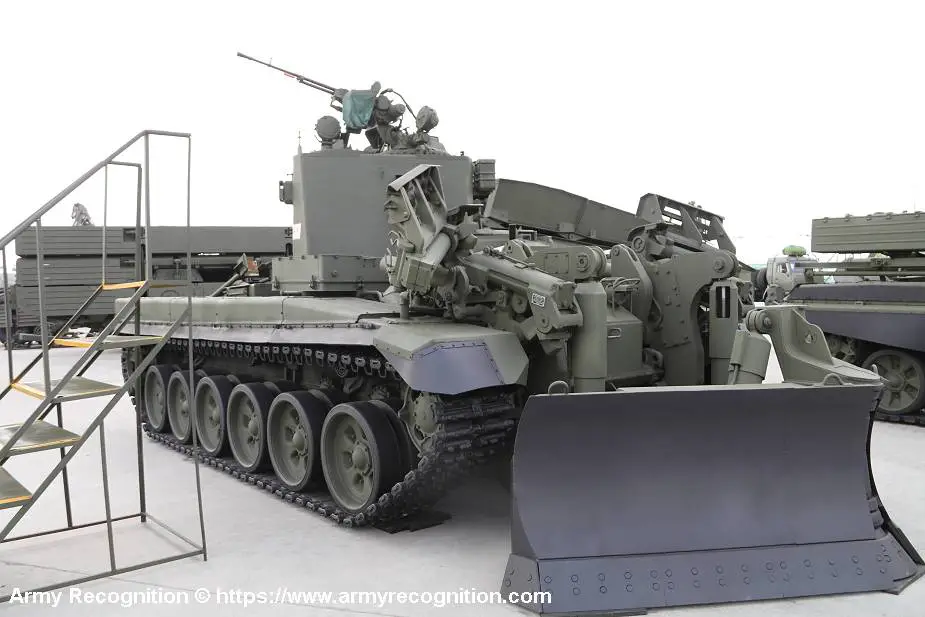
IMR-3M tracked engineer armored vehicle. (Picture source Army Recognition)
IMR-3M
The IMR-3M is a tracked engineer armored vehicle base on the T-90 tank chassis. It is designed to remove obstacles on the battlefield under the fire of the enemy. It features a multipurpose dozer blade mounted at the front of the hull, a crane, and a mine clearance plow.
The IMR-3MA is powered by a four-stroke multi-fuel diesel V-84MS liquid-cooled engine developing 840 hp. It can reach a top road speed of 62 km/h. The whole vehicle can be operated under armor by a crew of two-man, a 12.7mm anti-aircraft machine gun has been provided for self-defense purposes.
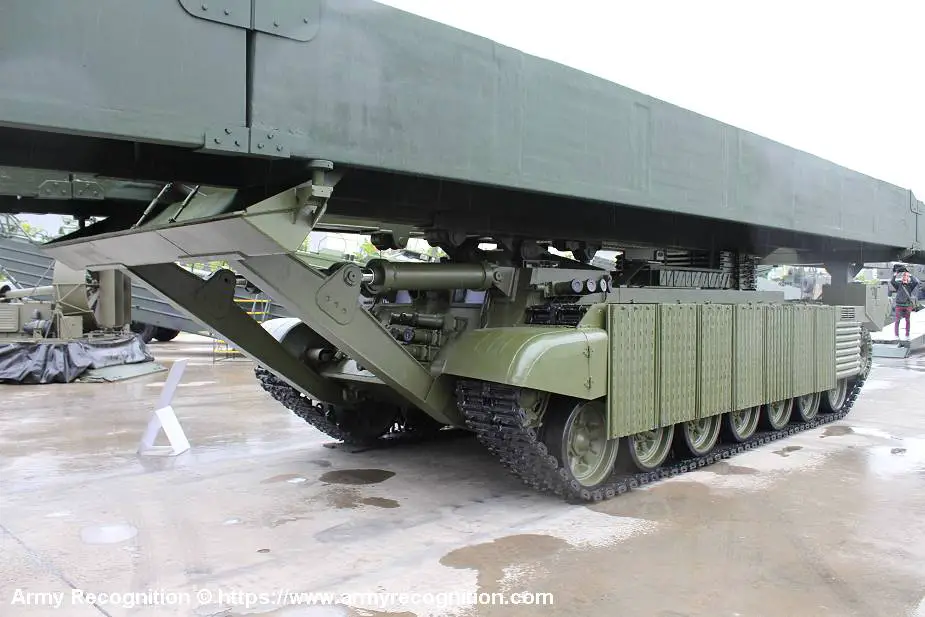
MTU-2020 bridge layer engineer armored vehicle based on T-90 tank chassis. (Picture source Army Recognition)
MTU-2020
The MTU-20020 is a new bridge layer tank engineer vehicle based on the tracked chassis of the T-90A with an extended chassis with one more wheel. The suspension of the T-90A consists of six dual rubber-tired road wheels with the drive sprocket at the rear, an idler at the front, and three track return rollers. The MTU-2020 has seven road wheels. It has a crew of two.
The MTU-2020 is designed to provide tank units with a bridge of 27 m offering capabilities to cross ditches, channels and rivers, and other obstacles. The tank is equipped with a single bridge that can be deployed in less than five minutes. It can run at a maximum road speed of 60 km/h.

Uran-6 robotic mine clearing system engineer combat vehicle. (Picture source Army Recognition)
URAN-6
The Uran-6 is a multi-functional, mine-clearing tracked robotic system manufactured by JSC 766 UPTK for the Russian Armed Forces. It is designed to perform mine reconnaissance and area clearance operations and detect and remove explosive ordnance and anti-personnel as well as anti-tank mines.
The Uran-6 is fitted with one bulldozer blade and trawls mounted at the front of the hull. It can be also fitted with a full range of tools, such as a tiller, segmented roller, dozer blade, gripper, rear forklift, rear shovel and robotic arm.
The Uran-6 is still not fully trusted and is followed by sappers who verify how efficiently the Uran-6 has cleared the zone. The Uran-6 can be controlled up to a distance of 1,500 m and has a battery capacity up to 16 hours. It is also able to perform self-recovery from a ditch/channel by using its hydraulic arms (extend/retract positions).


























